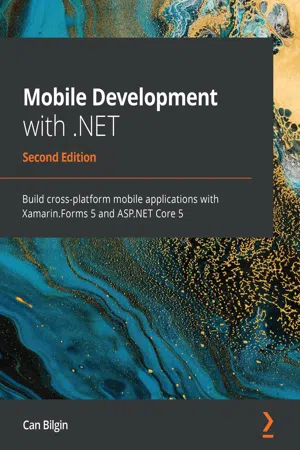
Mobile Development with .NET
Build cross-platform mobile applications with Xamarin.Forms 5 and ASP.NET Core 5, 2nd Edition
- 572 pages
- English
- ePUB (mobile friendly)
- Available on iOS & Android
Mobile Development with .NET
Build cross-platform mobile applications with Xamarin.Forms 5 and ASP.NET Core 5, 2nd Edition
About this book
A mobile applications development masterclass for.NET and C# developers
Key Features
- Uncover the new features and capabilities of the.NET 5 framework in this updated and improved second edition
- Optimize the time required to develop highly performant cross-platform applications
- Understand the architectural patterns and best practices for mobile application development
Book Description
Are you a.NET developer who wishes to develop mobile solutions without delving into the complexities of a mobile development platform? If so, this book is a perfect solution to help you build professional mobile apps without leaving the.NET ecosystem.
Mobile Development with.NET will show you how to design, architect, and develop robust mobile applications for multiple platforms, including iOS, Android, and UWP using Xamarin, .NET Core, and Azure.
With the help of real-world scenarios, you'll explore different phases of application development using Xamarin, from environment setup, design, and architecture to publishing. Throughout the book, you'll learn how to develop mobile apps using Xamarin and.NET Standard. You'll even be able to implement a web-based backend composed of microservices with.NET Core using various Azure services including, but not limited to, Azure Active Directory, Azure Functions. As you advance, you'll create data stores using popular database technologies such as Cosmos DB and data models such as the relational model and NoSQL.
By the end of this mobile application development book, you'll be able to create cross-platform mobile applications that can be deployed as cloud-based PaaS and SaaS.
What you will learn
- Discover the latest features of.NET 5 that can be used in mobile application development
- Explore Xamarin.Forms Shell for building cross-platform mobile UIs
- Understand the technical design requirements of a consumer mobile app
- Get to grips with advanced mobile development concepts such as app data management, push notifications, and graph APIs
- Manage app data with Entity Framework Core
- Use Microsoft's Project Rome for creating cross-device experiences with Xamarin
- Become well-versed with implementing machine learning in your mobile apps
Who this book is for
This book is for ASP.NET Core developers who want to get started with mobile development using Xamarin and other Microsoft technologies. Working knowledge of C# programming is necessary to get started.
Frequently asked questions
- Essential is ideal for learners and professionals who enjoy exploring a wide range of subjects. Access the Essential Library with 800,000+ trusted titles and best-sellers across business, personal growth, and the humanities. Includes unlimited reading time and Standard Read Aloud voice.
- Complete: Perfect for advanced learners and researchers needing full, unrestricted access. Unlock 1.4M+ books across hundreds of subjects, including academic and specialized titles. The Complete Plan also includes advanced features like Premium Read Aloud and Research Assistant.
Please note we cannot support devices running on iOS 13 and Android 7 or earlier. Learn more about using the app.
Information
Section 1: Understanding .NET
- Chapter 1, Getting Started with .NET 5.0
- Chapter 2, Defining Xamarin, Mono, and .NET Standard
- Chapter 3, Developing with Universal Windows Platform
Chapter 1: Getting Started with .NET 5.0
- Exploring cross-platform development
- Understanding .NET Core
- Developing with .NET 5.0
Technical Requirements
Exploring cross-platform development
- Fully native applications
- Hybrid applications
- Cross-platform
Developing fully native applications
Hybrid applications
Table of contents
- Mobile Development with .NET
- Second Edition
- Preface
- Section 1: Understanding .NET
- Chapter 1: Getting Started with .NET 5.0
- Chapter 2: Defining Xamarin, Mono, and .NET Standard
- Chapter 3: Developing with Universal Windows Platform
- Section 2: Xamarin and Xamarin.Forms
- Chapter 4: Developing Mobile Applications with Xamarin
- Chapter 5: UI Development with Xamarin
- Chapter 6: Customizing Xamarin.Forms
- Section 3: Azure Cloud Services
- Chapter 7: Azure Services for Mobile Applications
- Chapter 8: Creating a Datastore with Cosmos DB
- Chapter 9: Creating Microservices Azure App Services
- Chapter 10: Using .NET Core for Azure Serverless
- Section 4: Advanced Mobile Development
- Chapter 11: Fluid Applications with Asynchronous Patterns
- Chapter 12: Managing Application Data
- Chapter 13: Engaging Users with Notifications and the Graph API
- Section 5: Application Life Cycle Management
- Chapter 14: Azure DevOps and Visual Studio App Center
- Chapter 15: Application Telemetry with Application Insights
- Chapter 16: Automated Testing
- Chapter 17: Deploying Azure Modules
- Chapter 18: CI/CD with Azure DevOps
- Other Books You May Enjoy